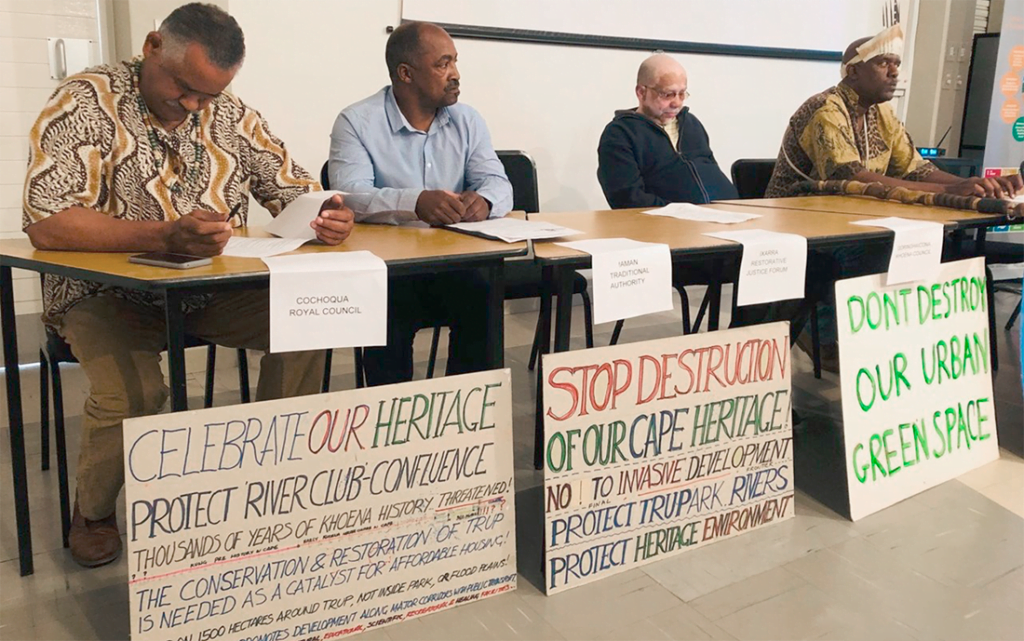article by Sonja Schoeman – Daily Maverick 19 December 2019
‘!Khutse hui ida |hoaba sida lumisa’ (Creator, help us to unite for our natural and cultural heritage) and save Two Rivers Urban Park. This prayer was made by Bradley van Sitters, President Cyril Ramaphosa’s imbongi, at a gathering on Wednesday of five First Nations groups, and more than 30 civic organisations and environmental groups in the growing fight against the proposed River Club development in Cape Town.
A gathering of First Nations groups and more than 30 civic organisations and environmental groups announced the intention to collectively apply for provincial heritage status for Cape Town’s Two Rivers Urban Park (TRUP) at the confluence of the Black and Liesbeek rivers.
The area is a place of deep history, they say, and potentially a place of healing important to all South Africans. The heritage move aims to galvanise Heritage Western Cape (HWC) to carry out its own assessment of the broader precinct in the hope of protecting it.
There is a provisional protection order on the River Club property alone, which ends early in 2020. However, it has been mired in appeals from the developer, the City of Cape Town and two provincial departments.
Melvin Christian Arendse of the Qoranha Transfrontier, said yesterday that the First Nations had asked the civics to support an immediate application for provisional protection for the broader area — and they also intend to apply for national heritage status. The other First Nations represented were the Goringhaicona XhoiXhoi Traditional Council, the !Aman Traditional Authority, the !Xarra Restorative Justice Forum and the Cochoqua Royal Council.
“The purpose of this is to mobilise public support from a range of different stakeholders for the idea that this area is really important,” said Observatory Civic Association (OCA) chairman Leslie London. “It’s sacred, it’s important for our heritage. It’s important for the Xhoi and the First Nations, but also for all of us in South Africa and also everyone on the planet because of the deep, deep history.”
The joint press conference was held at the South African Astronomical Observatory’s (SAAO) auditorium, which will be in the teeth of the development proposed by Liesbeek Leisure Property Trust (LLPT) should it go ahead. The SAAO is a national monument in line for World Heritage Status and has itself independently objected to the development; it is not part of the collective application.
Wednesday 18 December 2019 was also the deadline set by the City for comment on its Local Spatial Development Framework for the area. LLPT has proposed an extensive R4-billion development for residential and commercial use. The objecting collective said yesterday the proposed development has been written into the framework, paving the way for it to go ahead.
On Wednesday, they presented an impassioned picture of the area not only as a place where South Africa’s beginnings and soul are rooted, full of memory for nations who had been erased systematically from the country’s history by colonial forces, but also potentially as a place of healing for the nation.
It was here in 1510 that the first battles against the Portuguese oppressors were fought and won, said Tauriq Jenkins, Supreme High Commissioner of the Goringhaicona Khoema Council and member of the OCA.
“So this is a place of the first encounter of ground zero, but also a place where we can hold a reconciliation of an entire nation, a reconciliation of healing that has not taken place since… that moment when that ancient pole was placed on this ancient terrain and the iron fence put up by Jan van Riebeek that divided us.”
Arendse said Observatory, along with Kalk Bay and Muizenberg, was one of the last bits of romance in Cape Town’s infrastructure and society, and it was lunacy to bring the huge development along with its huge waste pollution problems to the rivers.
Also present were Paramount chief Aran of the Garinghaicona XhoiXhoi Traditional Council, Paramount Chief Fredericks of the !Aman and Nama, as well as Chief Noel, political adviser to the Paramountcy Johannes of Cochoqua.
Members of the supporting civics also spoke, including William Leith of the Princess Vlei Forum, who said the process for its heritage application was already quite advanced and it believed the process could be replicated in Observatory and around the country.
Numerous environmental organisations were also present. The proposed development, set at the confluence of the Black and Liesbeek rivers, has implications for the wetland, water retention and the wildlife and ecosystems there. DM


